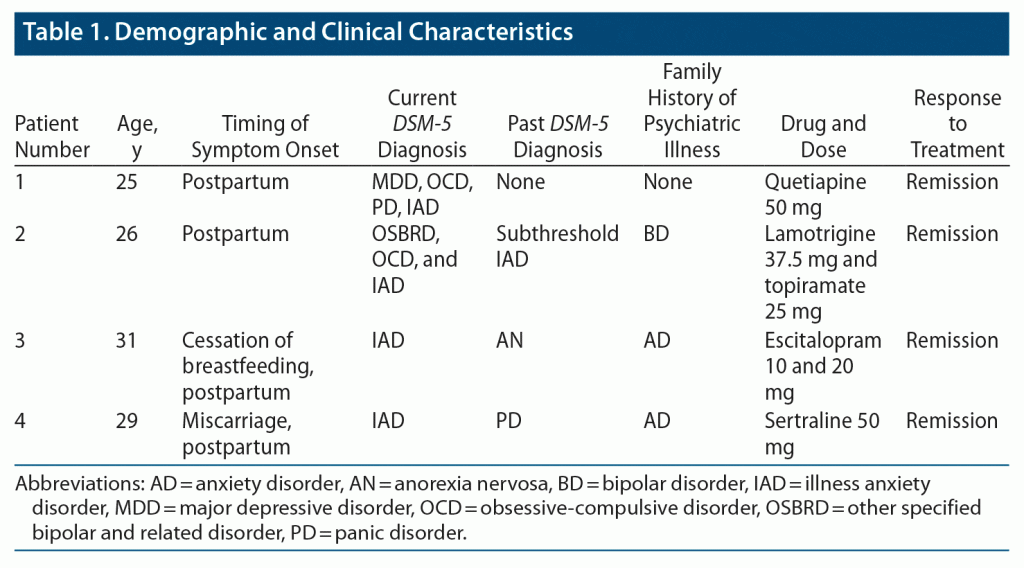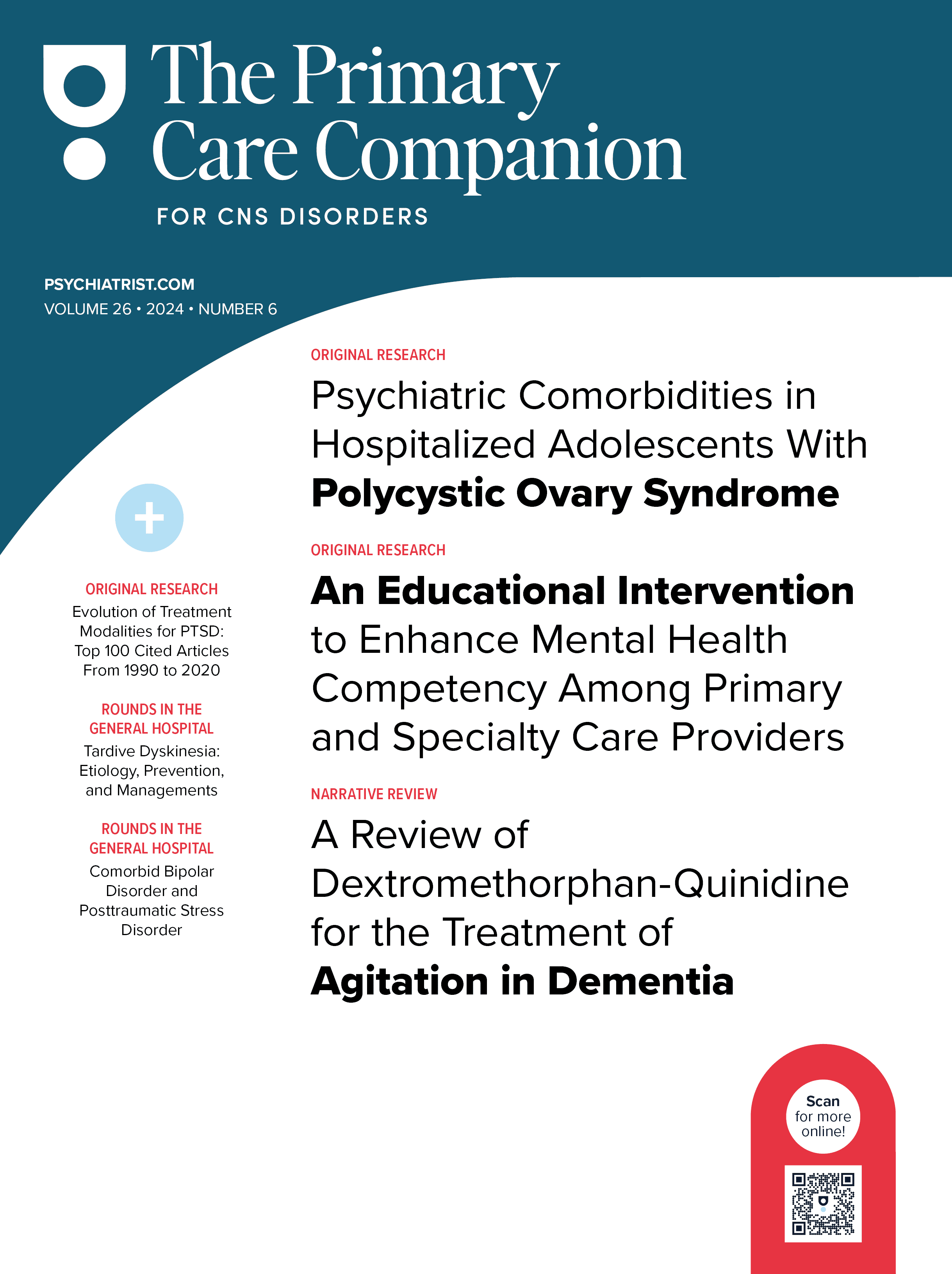![]()
Prim Care Companion CNS Disord 2021;23(4):20l02748
To cite: Sharma V. Illness anxiety disorder in the peripartum period. Prim Care Companion CNS Disord. 2021;23(4):20l02748.
To share: https://doi.org/10.4088/PCC.20l02748
© Copyright 2021 Physicians Postgraduate Press, Inc.
aDepartment of Psychiatry, Western University, London, Ontario, Canada
bDepartment of Obstetrics and Gynecology, Western University, London, Ontario, Canada
cParkwood Institute Mental Health Care, London, Ontario, Canada
*Corresponding author: Verinder Sharma, MBBS, Parkwood Institute Mental Health Care Bldg, PO Box 5777, Stn B, London, Ontario N6A 4V2, Canada ([email protected]).
Illness anxiety disorder, previously referred to as hypochondriasis, is classified as a somatic symptom and related disorder in the Diagnostic and Statistical Manual of Mental Disorders, Fifth Edition (DSM-5).1 The cardinal feature of the disorder is the persistent preoccupation with thoughts of having or acquiring a serious physical illness. Physical symptoms are either absent or of mild intensity; however, there is a heightened level of anxiety about health matters. Neither appropriate medical reassurance nor negative results of investigations assuage patients’ concerns about health.1
Individuals with illness anxiety disorder are more likely to be encountered in primary care settings than in mental health facilities.2 Prevalence of illness anxiety disorder is largely unknown, but the 1- to 2-year estimates of DSM-III– and DSM-IV–defined hypochondriasis vary from 1.3% to 10% in the general population.1 Illness anxiety disorder is equally common in males and females. With onset in early or middle adulthood, the disorder follows a chronic course in some individuals and causes role impairment and disruptions in family life. There is contradictory information about the effect of pregnancy on health anxiety3; however, it is unclear whether other reproductive events such as childbirth affect the course of illness anxiety disorder.
Case Series
Presented here are 4 cases of women who experienced onset or recurrence of illness anxiety disorder in the peripartum period. See Table 1 for details of the demographic and clinical characteristics. At the time of assessment at our clinic, the women were concerned about feeling anxious rather than being preoccupied with thoughts of having a serious physical illness. To illustrate presentation of illness anxiety disorder, a case (patient number 3 in Table 1) is described in some detail. The patient developed health anxiety after her first delivery with worsening of symptoms following cessation of breastfeeding 16 months postpartum. She became preoccupied with thoughts of having cancer because of numbness of her tongue and a burning sensation in her throat. She was assessed by 3 otolaryngologists and had a magnetic resonance imaging scan of the neck. All of the investigations yielded normal results. She was treated with cognitive-behavioral therapy and escitalopram 20 mg daily, resulting in remission of symptoms. She discontinued the medication prior to her next pregnancy. A few days after her second delivery, she became preoccupied with thoughts of dying from cancer, requiring a retrial of escitalopram 10 mg daily. A couple of weeks later, the health anxiety remitted, and she has been in remission for 10 months.
In psychiatric settings, the diagnosis of illness anxiety disorder can be particularly challenging because patients are often reluctant to share physical health concerns with mental health professionals.4 Some patients may have illness anxiety during or after pregnancy; however, they may not qualify for the DSM-5 diagnosis of illness anxiety disorder due to the shorter duration of symptoms than required by the DSM-5 (6 months).
Discussion
In the cases reported here, the illness anxiety disorder occurred in the context of an existing psychiatric disorder or began simultaneously with other psychiatric disorders. Thus, women with common psychiatric disorders who are preoccupied with having or developing a serious illness should be evaluated for illness anxiety disorder. A review of the patient’s history of medical complaints and results of the physical examination and laboratory tests is essential to confirm a diagnosis of illness anxiety disorder and ascertain the extent of health care utilization.2 Overall, there was a marked reduction in health care utilization, including psychiatric services, in all of the cases presented. It could be argued that the symptoms of illness anxiety disorder resolved as a result of the treatment of comorbid psychiatric disorders. However, this was not the case because the symptoms of illness anxiety disorder persisted following resolution of comorbid disorders.
Published online: July 8, 2021.
Potential conflicts of interest: Dr Sharma reports personal fees from the Neuroscience Education Institute; grants from Assurex, Genome Canada, Sage Therapeutics, Stanley Medical Research Institute, and Sunovion Pharmaceuticals; and participation on the advisory boards for Sunovion Pharmaceuticals and Otsuka, outside the submitted work.
Funding/support: None.
Acknowledgments: The author thanks Christine Baczynski, MPH (Parkwood Institute Mental Health Care, London, Ontario, Canada), for her help with preparing the manuscript. Ms Baczynski reports no conflicts of interest related to the subject of this report.
Patient consent: The patients provided consent to have their cases published, and identifying details have been changed.
References (4)

- American Psychiatric Association. Diagnostic and Statistical Manual for Mental Disorders. Fifth Edition. Washington, DC: American Psychiatric Association; 2013.
- Levenson JL. Illness anxiety disorder: Treatment and prognosis. UpToDate. Published 2020. Accessed May 21, 2020. https://www.uptodate.com/contents/illness-anxiety-disorder-treatment-and-prognosis
- Kowalyk KM, Hadjistavropoulos HD, Jones SL. What impact does pregnancy have on anxiety about health? J Psychosom Obstet Gynaecol. 2009;30(4):223–230. PubMed CrossRef
- Gerstenblith T, Stern T. Primary care and consultation-liaison interventions for somatic symptom and related disorders. In: Gabbard’s Treatments of Psychiatric Disorders. Fifth edition. Washington, DC: American Psychiatric Publishing; 2014:571.
Please sign in or purchase this PDF for $40.
Save
Cite


